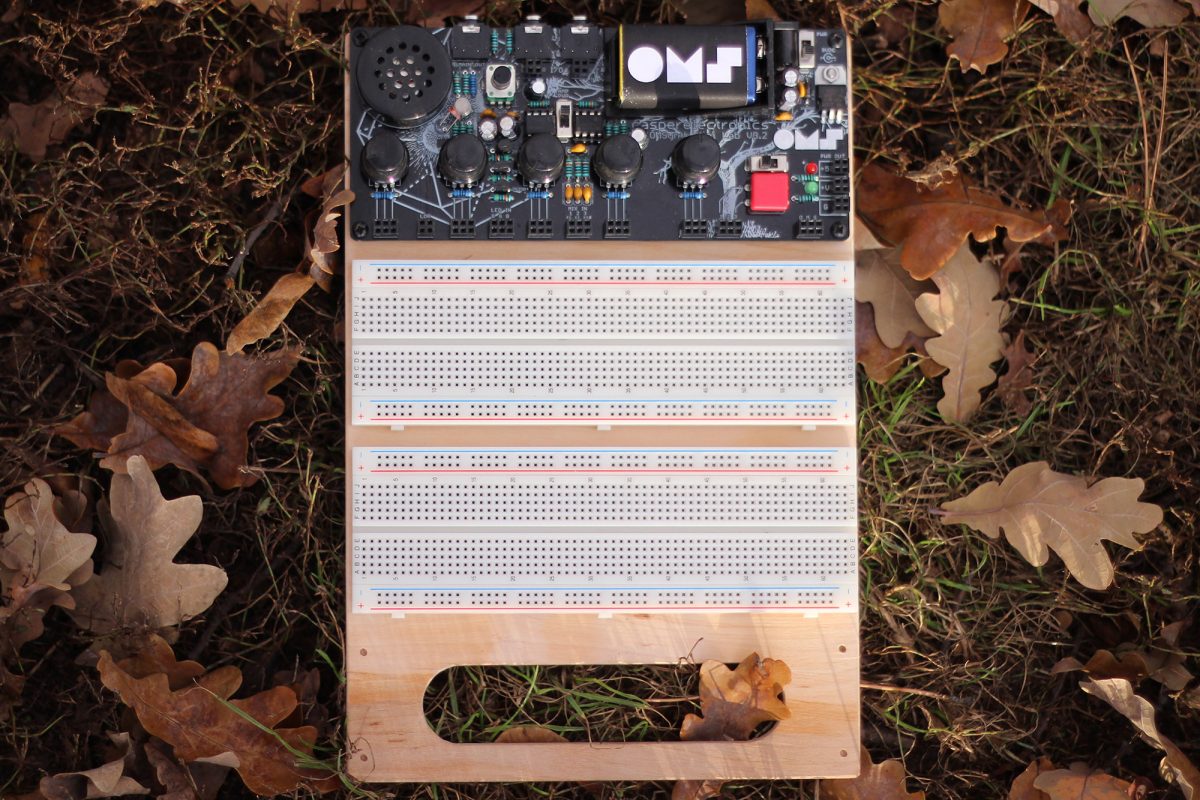Casper Electronics has officially introduced the OMSynth miniLab – a circuit development and performance interface designed to help inventors quickly build and experiment with creative circuits
The OMSynth offers all you need to start inventing circuits to make sound and light. Potentiometers, audio mixer, speaker, headphone output, battery or adapter power and more.
Here’s a video intro from creator Peter Edwards:
Features:
- Battery (included) or 9V wall wart power options (not included)
- Regulated 5V and unregulated power sockets
over-current protection fuse (200ma) protects circuit from shorts or improperly installed ICs - 3 channel audio mixer with individually weighted inputs (x1, x1 and x10)
- Amplified speaker with volume control
- Dual mono headphone output
- 2 stereo I/O jacks for connecting to external circuits, modular synths, etc
- Tri-color LED with discrete channel drivers
- Light sensor for light based variation of circuit parameters
- The light sensor is installed facing the LED making it a basic vactrol (voltage to resistance converter)
- 3 touch sensors (the OMS logo) for touch based manipulation of circuit parameters
- 5 modular 100k potentiometers (protected by 1k buffer)
- 1 modular pushbutton and integrated on/off switch
- 2 full size breadboards
- Laser engraved base plate with a carrying handle
- Expansion section for adding control boards or custom circuits
The Casper Electronics OMSynth MiniLab are available now via Noise Kitchen.


nice ! but how to begin when you are beginner with this ? ? (so book to read ? or is it only for grader people..?)
An atari punk console’s probably a good start; a quick internet search’ll throw up a variety of designs. If you want to start really simple, a schmitt trigger oscillator’s about as simple as you can get; One chip, a capacitor, and a pot. Additionally, your average schmitt inverter chip has about 6 gates on the chip, so you can build another 6 oscillators without much extra trouble. Hackaday have a decent series of tutorials over here: http://hackaday.com/2015/02/04/logic-noise-sweet-sweet-oscillator-sounds/
Alternatively, if you’d feel more happy doing some code-bashing, you could pop an arduino micro into the board, and use one of the audio libraries available; MOZZI (http://sensorium.github.io/Mozzi/) is pretty good, and quite easy to get your head round. Also, if you go with the micro, it should be possible to hook up USB MIDI pretty easily, which’d open up a few options (hardware MIDI’s not too hard to get going, either).
Peter has You Tube videos up showing how to make various simple circuits. I’ve just been watching them myself. Anyone with a brain cell should be able to make a start.
Thank you @mushroomglue for this !! i actually looking for a arduino starter pack (good idea ??), i have ever do some kit (like apc or baslt trinity) but i don’t know how to have a good introduce to this electronic / program world… i go to see your link…. what is the more simple for you for a noob (old) ? this arduino kit ? for mozzi i know i have ever buid some trinity bastl who can use it, but never try it….
RE arduino stuff, on second thoughts, one of the 32bit teensy’d probably be a better shout, as they’ve got a bit more horsepower and a better internal ADC: https://www.pjrc.com/teensy/
As for what’d be best, or simplest, I don’t really know; Doing hardware’s a bit more hands-on and low-level, but the more complexity you pull in, the more physical parts you need; I did a single-oscillator synth with a sequencer and a resonant filter at A-level on breadboards, and that took three breadboards, with virtually no space unused. The microcontroller route will probably get you making better sounds quicker, but you’ll have to get your head around coding, and it possibly isn’t as clear as a learning tool. Personally, my advice would be to roll with both; Pick up some cheap logic ICs (Schmitt inverters and decade counters are fun for this sort of stuff), some op-amps (741’s or LM324’s are a good standard ones to have around, however a quite a few of the easier-to-make VCFs use transconductance op-amps like the LM13700, so it’s probably worth having a few of them, too), and a few other assorted capacitors and resistors (you can usually get packs of them on amazon or ebay; probably easiest), but pick up a microcontroller board like a teensy or an arduino too. That way, you can enjoy the advantages of each, and also do hybrid stuff.
Maybe too advanced for people who just want to make sound, but a good way to dive into electronics. After all you will be able to build a lot of own stuff. Good marketing philosophy if you don´t want to sell your own prebuild products in the future and to educate a independent community. If you got enough time for this you will maybe create some usefull sound at the end 😀
Thank you for your answers.
Well, maybe all that it is too advance for me, better for student or creator 🙁
I don’t know….
but, i’m very interesting by this thing, just i don’t know how begin (but yes, that will be just a good pass time for me and new sound laboratory toy too !!)
so i discovered the bitRanger, maybe go on this way…in this first time..!!